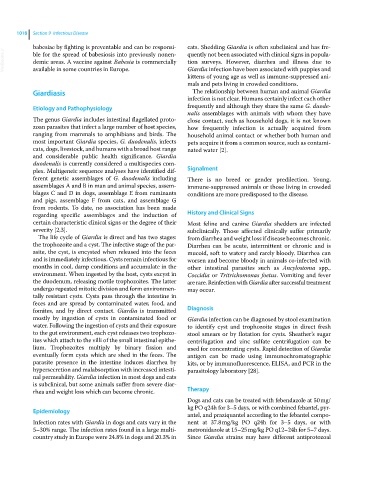Page 1080 - Clinical Small Animal Internal Medicine
P. 1080
1018 Section 9 Infectious Disease
babesiae by fighting is preventable and can be responsi- cats. Shedding Giardia is often subclinical and has fre-
VetBooks.ir ble for the spread of babesiosis into previously nonen- quently not been associated with clinical signs in popula-
tion surveys. However, diarrhea and illness due to
demic areas. A vaccine against Babesia is commercially
Giardia infection have been associated with puppies and
available in some countries in Europe.
kittens of young age as well as immune‐suppressed ani-
mals and pets living in crowded conditions.
Giardiasis The relationship between human and animal Giardia
infection is not clear. Humans certainly infect each other
Etiology and Pathophysiology frequently and although they share the same G. duode-
nalis assemblages with animals with whom they have
The genus Giardia includes intestinal flagellated proto- close contact, such as household dogs, it is not known
zoan parasites that infect a large number of host species, how frequently infection is actually acquired from
ranging from mammals to amphibians and birds. The household animal contact or whether both human and
most important Giardia species, G. duodenalis, infects pets acquire it from a common source, such as contami-
cats, dogs, livestock, and humans with a broad host range nated water [2].
and considerable public health significance. Giardia
duodenalis is currently considered a multispecies com-
plex. Multigeneic sequence analyses have identified dif- Signalment
ferent genetic assemblages of G. duodenalis including There is no breed or gender predilection. Young,
assemblages A and B in man and animal species, assem- immune‐suppressed animals or those living in crowded
blages C and D in dogs, assemblage E from ruminants conditions are more predisposed to the disease.
and pigs, assemblage F from cats, and assemblage G
from rodents. To date, no association has been made
regarding specific assemblages and the induction of History and Clinical Signs
certain characteristic clinical signs or the degree of their Most feline and canine Giardia shedders are infected
severity [2,3]. subclinically. Those affected clinically suffer primarily
The life cycle of Giardia is direct and has two stages: from diarrhea and weight loss if disease becomes chronic.
the trophozoite and a cyst. The infective stage of the par- Diarrhea can be acute, intermittent or chronic and is
asite, the cyst, is encysted when released into the feces mucoid, soft to watery and rarely bloody. Diarrhea can
and is immediately infectious. Cysts remain infectious for worsen and become bloody in animals co‐infected with
months in cool, damp conditions and accumulate in the other intestinal parasites such as Ancylostoma spp.,
environment. When ingested by the host, cysts excyst in Coccidia or Tritrichomonas foetus. Vomiting and fever
the duodenum, releasing motile trophozoites. The latter are rare. Reinfection with Giardia after successful treatment
undergo repeated mitotic division and form environmen- may occur.
tally resistant cysts. Cysts pass through the intestine in
feces and are spread by contaminated water, food, and
fomites, and by direct contact. Giardia is transmitted Diagnosis
mostly by ingestion of cysts in contaminated food or Giardia infection can be diagnosed by stool examination
water. Following the ingestion of cysts and their exposure to identify cyst and trophozoite stages in direct fresh
to the gut environment, each cyst releases two trophozo- stool smears or by flotation for cysts. Sheather’s sugar
ites which attach to the villi of the small intestinal epithe- centrifugation and zinc sulfate centrifugation can be
lium. Trophozoites multiply by binary fission and used for concentrating cysts. Rapid detection of Giardia
eventually form cysts which are shed in the feces. The antigen can be made using immunochromatographic
parasite presence in the intestine induces diarrhea by kits, or by immunofluorescence, ELISA, and PCR in the
hypersecretion and malabsorption with increased intesti- parasitology laboratory [28].
nal permeability. Giardia infection in most dogs and cats
is subclinical, but some animals suffer from severe diar-
rhea and weight loss which can become chronic. Therapy
Dogs and cats can be treated with febendazole at 50 mg/
kg PO q24h for 3–5 days, or with combined febantel, pyr-
Epidemiology
antel, and praziquantel according to the febantel compo-
Infection rates with Giardia in dogs and cats vary in the nent at 37.8 mg/kg PO q24h for 3–5 days, or with
5–30% range. The infection rates found in a large multi- metronidazole at 15–25 mg/kg PO q12–24h for 5–7 days.
country study in Europe were 24.8% in dogs and 20.3% in Since Giardia strains may have different antiprotozoal

